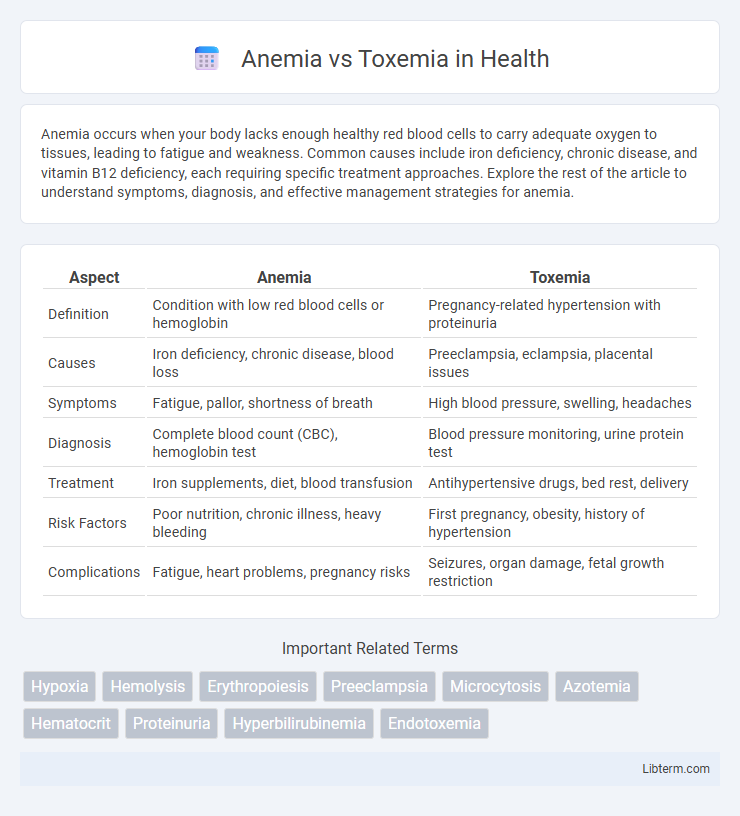Anemia occurs when your body lacks enough healthy red blood cells to carry adequate oxygen to tissues, leading to fatigue and weakness. Common causes include iron deficiency, chronic disease, and vitamin B12 deficiency, each requiring specific treatment approaches. Explore the rest of the article to understand symptoms, diagnosis, and effective management strategies for anemia.
Table of Comparison
| Aspect | Anemia | Toxemia |
|---|---|---|
| Definition | Condition with low red blood cells or hemoglobin | Pregnancy-related hypertension with proteinuria |
| Causes | Iron deficiency, chronic disease, blood loss | Preeclampsia, eclampsia, placental issues |
| Symptoms | Fatigue, pallor, shortness of breath | High blood pressure, swelling, headaches |
| Diagnosis | Complete blood count (CBC), hemoglobin test | Blood pressure monitoring, urine protein test |
| Treatment | Iron supplements, diet, blood transfusion | Antihypertensive drugs, bed rest, delivery |
| Risk Factors | Poor nutrition, chronic illness, heavy bleeding | First pregnancy, obesity, history of hypertension |
| Complications | Fatigue, heart problems, pregnancy risks | Seizures, organ damage, fetal growth restriction |
Introduction to Anemia and Toxemia
Anemia is a medical condition characterized by a deficiency in the number or quality of red blood cells, leading to reduced oxygen delivery to tissues and symptoms such as fatigue, weakness, and pallor. Toxemia, often related to pregnancy (preeclampsia), involves the presence of toxins or harmful substances in the bloodstream, causing hypertension, proteinuria, and potential organ damage. Understanding the distinct pathological mechanisms of anemia and toxemia is essential for accurate diagnosis and targeted treatment strategies.
Defining Anemia: Causes and Symptoms
Anemia is a medical condition characterized by a deficiency in the number or quality of red blood cells or hemoglobin, leading to reduced oxygen transport in the body. Common causes include nutritional deficiencies (iron, vitamin B12, folate), chronic diseases, blood loss, and genetic disorders such as sickle cell anemia. Symptoms often involve fatigue, pallor, shortness of breath, and dizziness, reflecting the body's impaired ability to deliver adequate oxygen to tissues.
Understanding Toxemia: Types and Triggers
Toxemia, also known as preeclampsia in pregnancy, is characterized by high blood pressure and protein in the urine, distinct from anemia, which involves reduced red blood cells or hemoglobin levels. The primary types of toxemia include gestational hypertension, preeclampsia, and eclampsia, each with varying severity and potential complications. Common triggers for toxemia involve underlying conditions such as chronic hypertension, diabetes, obesity, and autoimmune disorders, emphasizing the importance of monitoring these risk factors during pregnancy.
Key Differences Between Anemia and Toxemia
Anemia is characterized by a deficiency in red blood cells or hemoglobin, leading to reduced oxygen transport in the body, whereas toxemia refers to the presence of toxins in the bloodstream, often associated with conditions like preeclampsia during pregnancy. Anemia typically causes symptoms such as fatigue, pallor, and weakness, while toxemia manifests with high blood pressure, swelling, and the presence of protein in urine. The diagnostic approach for anemia includes complete blood count tests, while toxemia requires monitoring blood pressure, urine protein levels, and kidney function tests.
Risk Factors for Anemia vs Toxemia
Risk factors for anemia include nutritional deficiencies such as low iron, vitamin B12, or folate intake, chronic diseases like kidney disease or cancer, and blood loss from surgery or menstruation. In contrast, toxemia, often linked to pregnancy-induced hypertension, is primarily associated with maternal hypertension, obesity, first-time pregnancy, and underlying chronic conditions like diabetes or kidney disease. Understanding these distinct risk profiles aids in targeted prevention and management strategies for each condition.
Diagnostic Approaches: Anemia vs Toxemia
Diagnostic approaches for anemia primarily involve complete blood count (CBC) tests to measure hemoglobin levels, hematocrit, and red blood cell count, alongside peripheral blood smears to identify morphological abnormalities. In contrast, toxemia diagnosis relies on assessing clinical symptoms such as hypertension, proteinuria, and edema, supported by laboratory tests including urine protein analysis and liver function tests. Imaging techniques such as Doppler ultrasound may be used in toxemia cases to monitor fetal well-being and placental blood flow.
Treatment Strategies for Anemia
Treatment strategies for anemia primarily involve addressing the underlying cause, such as iron deficiency, vitamin B12 deficiency, or chronic disease. Iron supplementation, vitamin B12 injections, or erythropoiesis-stimulating agents are commonly prescribed to improve red blood cell production and oxygen transport capacity. In severe cases, blood transfusions may be necessary to quickly restore hemoglobin levels and alleviate symptoms.
Managing Toxemia: Best Practices
Managing toxemia requires early diagnosis and prompt medical intervention to prevent complications such as preeclampsia or eclampsia. Best practices include regular blood pressure monitoring, urine protein analysis, and adherence to prescribed medications like antihypertensives or magnesium sulfate. Lifestyle modifications such as reduced salt intake, adequate hydration, and monitored rest play a critical role in controlling symptoms and ensuring maternal-fetal health.
Prevention Tips for Both Conditions
Preventing anemia involves consuming iron-rich foods such as spinach, lentils, and red meat, along with vitamin C to enhance iron absorption, and avoiding excessive intake of caffeine which can inhibit iron uptake. To reduce the risk of toxemia, often associated with pregnancy-induced hypertension, regular prenatal checkups, maintaining a balanced diet low in salt, and managing stress levels are vital. Both conditions benefit from early detection and lifestyle modifications, promoting overall maternal and fetal health.
When to Seek Medical Assistance
Seek medical assistance for anemia if experiencing severe fatigue, chest pain, dizziness, or shortness of breath, as these symptoms indicate a potential emergency due to low red blood cell count or hemoglobin levels. In cases of toxemia, especially during pregnancy (preeclampsia), immediate medical attention is crucial if high blood pressure, severe headaches, vision changes, or swelling in the hands and face occur, to prevent complications like organ damage or seizures. Early diagnosis and treatment for both conditions significantly reduce risks and improve outcomes.
Anemia Infographic

 libterm.com
libterm.com